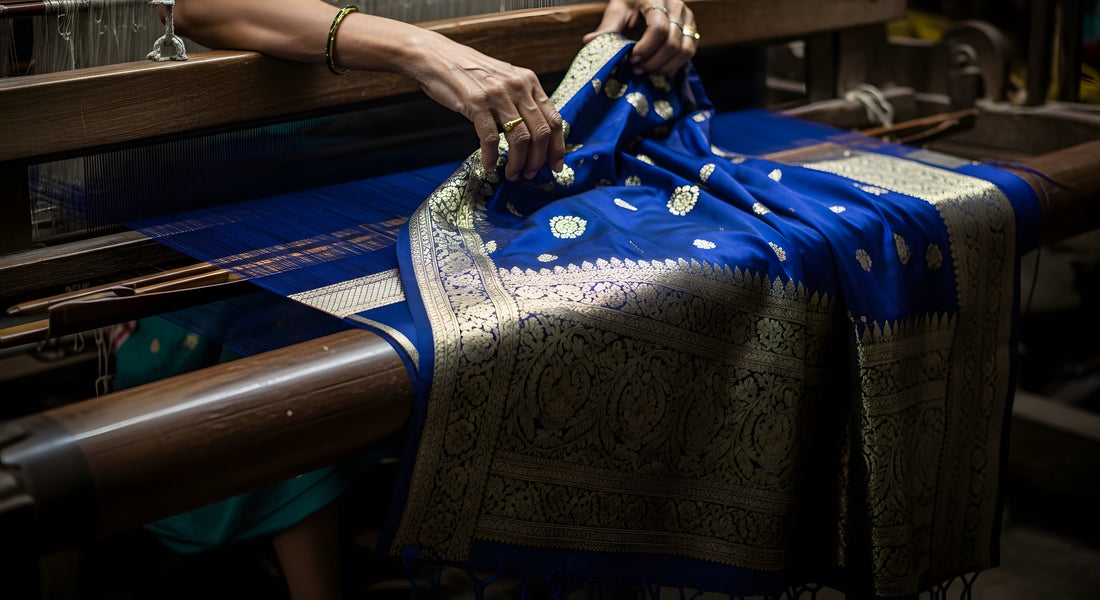
The Art of Slow Fashion: Handmade vs. Mass-Produced Outfits
The Art of Slow Fashion: Handmade vs. Mass-Produced Outfits
Oscar Wilde once said, “Fashion is a form of ugliness so intolerable that we have to alter it every six months.” This quote perfectly captures today’s fashion industry—fast trends, disposable clothing, and endless consumption. But as consumers become more conscious, a movement toward slow fashion is reshaping the industry.
At Plumvera, we proudly champion slow fashion and the art of handcrafted ethnic wear. From Handwoven Sarees , Artisan-Crafted Bags and Handmade Jewellery. we create fashion that tells a story while supporting ethical craftsmanship.
What is Slow Fashion?
Slow fashion emphasizes quality over quantity. Unlike fast fashion, which focuses on mass production and low-cost trends, slow fashion values sustainability, ethics, and timeless design.
A McKinsey report shows that 3 out of every 5 garments produced annually are discarded, contributing to fashion waste. Slow fashion combats this cycle by:
-
Designing durable clothing that lasts.
-
Promoting ethical sourcing and fair wages.
-
Using eco-conscious, handcrafted fabrics.
-
Encouraging mindful shopping habits over trend-chasing.
Slow fashion is not just a style choice; it’s a movement that empowers customers to invest in long-lasting pieces while helping artisans thrive.
Handmade Clothing: The Craft of Conscious Style
Slow fashion’s soul lies in handmade clothing, where artistry meets intention.
1. Sustainability First
Handmade garments reduce environmental damage by focusing on organic fabrics, natural dyes, and low-waste production. At Plumvera, our Handcrafted Kurtasand Handcrafted Kurta Sets are created to last, ensuring your fashion choices benefit both your wardrobe and the planet.
2. Masterful Artistry
Every Plumvera piece from block-printed sarees to hand-embroidered suits celebrates artisan skills passed down through generations. Each stitch is a work of cultural heritage.

3. Personal Connection
When you choose handcrafted ethnic wear, you’re supporting skilled artisans and their families, creating a meaningful bond between the maker and wearer.
Mass-Produced Fashion: Convenience at a Cost
Fast fashion, while affordable and trendy, often comes with hidden consequences:
-
Labor Exploitation
Many mass-production chains rely on low-wage labor in unsafe working conditions. -
Toxic Materials
Fast fashion uses harmful dyes and synthetic fabrics, harming workers, consumers, and the environment. -
Disposable Culture
Trends change quickly, encouraging customers to buy more, wear less, and throw away faster. -
Environmental Impact
Cheap, mass-produced clothing often ends up in landfills, polluting soil and water systems.
Fast vs. Slow Fashion: Making the Ethical Choice
By choosing Plumvera’s slow fashion collections, you’re not just buying clothes; you’re embracing a movement for conscious living.
-
You’ll get quality over quantity.
-
You’ll support artisan communities and fair wages.
-
You’ll own timeless wardrobe staples that won’t go out of style.
Explore our range of Explore our range of handcrafted Sarees, handcrafted Kurta sets, handmade most loved handbags, Merino wool stoles.
Why Handmade Slow Fashion is the Future
Slow fashion is a powerful answer to the environmental and ethical issues of fast fashion. Choosing handmade, artisan-crafted outfits helps:
-
Promote eco-friendly fashion.
-
Support artisan livelihoods and craftsmanship.
-
Build a wardrobe that reflects conscious choices and cultural heritage.
Plumvera is proud to be a slow fashion brand in India that blends heritage art with modern fashion sensibilities.
Conclusion: Fashion With Purpose
At Plumvera, fashion is about empowering artisans, celebrating Indian craftsmanship, and protecting the planet.
FAQs About Fast vs. Slow Fashion
1. What is the difference between fast fashion and slow fashion?
Fast fashion focuses on cheap, mass-market clothing, while slow fashion emphasizes handcrafted, sustainable, and ethically made garments.
2. Why is slow fashion better?
It protects the environment, artisans, and consumers while encouraging conscious consumption.
3. What makes fashion sustainable?
Organic fabrics, handmade production, fair wages, and cultural preservation define sustainable fashion.
4. Why is fast fashion harmful?
It pollutes ecosystems, exploits workers, and fuels overconsumption.
5. How do I switch from fast to slow fashion?
Start by buying from slow fashion brands like Plumvera, investing in handmade, durable clothing over trendy, disposable outfits.

5 comments
83t7kj
83t7kj
tm49gj
r6hnnd
b924oq